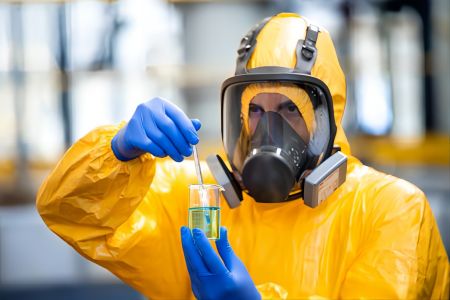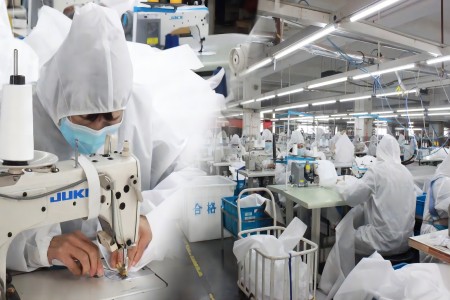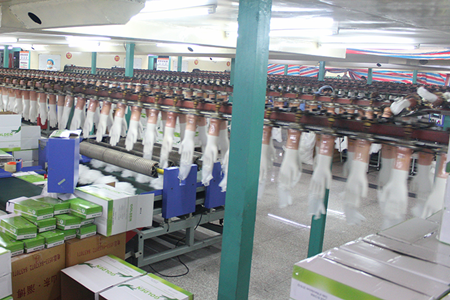2023/9/21

Beyond the Yellow Suit: The Science and Strategy of Hazmat Color Coding
If you picture a hazmat suit, a specific image likely comes to mind: a featureless, bright yellow figure. This iconic silhouette is synonymous with chemical safety, decontamination, and high-risk environments. But have you ever stopped to consider why this color is so prevalent, and what the alternatives signify for your operational planning?
For professionals in industrial safety, procurement, and facility management, understanding the design and color-coding of Personal Protective Equipment (PPE) is not just academic—it's a critical component of risk assessment and workplace safety protocols.
The Anatomy of a Modern Hazmat Suit
Before diving into color, it's essential to understand what a hazmat suit is designed to do. A fully-encapsulating hazmat suit is a wearable fortress, engineered to create a complete barrier between the wearer and hazardous materials, including chemicals, biological agents, and radiological particles.
A typical Level A (the highest level of protection) suit includes:
Full-Body Encapsulation: A one-piece garment with sealed seams.
Integrated Boots and Gloves: Often permanently attached to prevent any entry points.
Respiratory Protection: A contained, positive-pressure Self-Contained Breathing Apparatus (SCBA).
Face Shield or Visor: Made of durable, chemical-resistant material for visibility and protection.
Zippered Entry: A gas-tight zipper sealed with an overlapping storm flap.
The materials, such as Tyvek® or more advanced laminates like Butyl Rubber or Viton, are selected based on the specific chemical threats present.
The Color Code: Why Yellow Dominates the Landscape
While hazmat suits come in white, blue, orange, and even black, the vibrant "safety yellow" or "chartreuse" is by far the most recognized. The reasons are rooted in practicality, psychology, and physics.
High Visibility and Safety: This is the foremost reason. In a low-light environment, a smoke-filled room, or a complex industrial site, the bright yellow color stands out starkly against most backgrounds. It allows for quick location of personnel by teammates, supervisors, and emergency responders, ensuring no one is left behind and aiding in crowd control.
Universal Symbolism of Caution: Just like a yellow traffic light signals "caution," the color yellow on a hazmat suit immediately communicates "Danger: Hazardous Area." This non-verbal cue is understood across languages and cultures, reinforcing perimeter safety without a single word.
Contamination Indication: Many hazardous substances, including chemicals and biological powders, are dark in color. On a bright yellow or white suit, any splash, spill, or smear is immediately visible. This allows for rapid visual assessment of contamination, both during an operation and, crucially, during the decontamination (decon) process. A clean suit is a verified safe suit.
When Color is a Conscious Choice: The Alternatives
The choice of suit color is a deliberate specification, often tied to the application.
White Suits: Commonly used in cleanrooms, pharmaceutical settings, and for certain chemical responses. White is excellent for showing contamination and reflects heat, which can be a minor advantage in warm environments. It also conveys a sense of sterility and cleanliness.
Blue or Orange Suits: These are often used in training exercises or in lower-risk environments (e.g., asbestos abatement). The distinct color differentiates training gear from equipment reserved for actual emergencies, preventing cross-use and ensuring response-ready kits are always available.
Specialized Colors (Black/Green): Suits in darker colors may be used in specific scenarios, such as when working with light-sensitive materials or for tactical operations where high visibility is a disadvantage.
Strategic Takeaway for Your Business
For B2B decision-makers, the color of a hazmat suit is more than an aesthetic choice—it's a functional specification that impacts safety outcomes.
Procurement: When sourcing PPE, consider the work environment. Does your team operate in low-light conditions where high-visibility yellow is non-negotiable? Or is a sterile, white suit more appropriate for your contamination-control needs?
Training and Protocol: Use color to your advantage. Implementing a color-coded system (e.g., yellow for chemical response, white for bio-hazards) can streamline grab-and-go protocols in an emergency.
Risk Assessment: The suit's entire design, from its color to its material, should be a direct result of your facility's specific hazard analysis.
In conclusion, the iconic yellow hazmat suit is a masterpiece of practical design, where every element—including its vibrant color—is engineered to protect human life. By understanding the "why" behind the design, industry professionals can make more informed, strategic, and ultimately, safer choices for their teams and operations.




 WhatsApp
WhatsApp
Send us your message
You can send an email asking for the price and detailed information of this product. We will reply you as soon as we receive your email